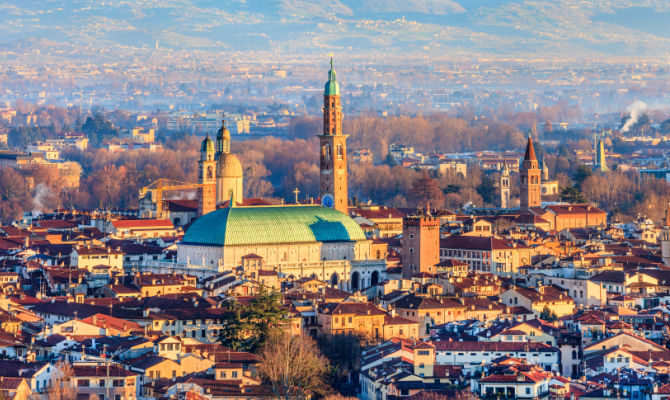Vicenza

Vicenza is an Italian town that is the capital of the province of the same name in the Veneto region.
The capital Berico is a destination for cultural tourism with flows from all over Italy and internationally and is nicknamed "the city of Palladio", from the name of the architect who designed most of his works here in the late Renaissance.
Constituting an exceptional artistic achievement for the numerous architectural contributions of Andrea Palladio, Vicenza has been declared a World Heritage Site by UNESCO.
Subjection to the Serenissima and the Vicenza Renaissance
From 1404 to 1797, by giving the keys of the city to Venice in 1414 (as did other Venetian and Lombard cities) it became part of the Venetian Republic with its capital or dominant Venice. Four centuries of peace and prosperity followed, in which the arts reached sublime levels and the economy prospered. On 12 June 1486 the Jews were expelled from Vicenza and, to meet the requests for loans of money, the Monte di Pietà was established at the same time.
The sixteenth century was the century of the great late Renaissance architect Andrea Palladio. Arrived as a young man in Vicenza from his native Padua, taken to heart by the Vicenza patron Gian Giorgio Trissino who made him study, Palladio proved to be one of the most influential personalities in the history of Western architecture.
The numerous noble families of Vicenza (the Porto, the Valmarana, the Thiene, the Trissino just to name a few) commissioned Palladio numerous palaces in the city as well as as many villas that completely redesigned the Vicenza scenography. Among the main works, the Palladian Basilica in the central Piazza dei Signori, the Olympic Theater, Palazzo Chiericati and Villa Capra called the Rotonda located just outside the town. The Palladian tradition was continued by Vincenzo Scamozzi and other architects until the 18th century.
There are few testimonies of the Baroque in the city: among these the Church of Santa Maria in Araceli, designed by the architect Guarino Guarini, in whose altars were placed paintings by Giambattista Tiepolo and the Piazzetta, and the Basilica of Monte Berico.
Contemporary age
During the First World War the mountains of the province of Vicenza were one of the major fronts of hostility of the whole conflict. After the war, the large square in front of the Basilica of Monte Berico was created, with the Italian flag in the center. From the balcony it is possible to see, thanks to special signs fixed in the stone, all the places where the main battles of the conflict took place.

The Second World War also affected the city, which was severely damaged by Allied bombing. The bombing began on Christmas Eve 1943 and will continue until the spring of 1945.
On April 2, 1944, the Verdi Theater, the Eretenio Theater (considered a small Phoenix) and the Canneti Auditorium were destroyed. The Olympic Theater is miraculously saved, which is located a few steps from the Auditorium.
Between 17 and 18 November 1944 the allies decide to hit the Vicenza Airport. The use of pin bombs, however, has repercussions on the populous district of San Bortolo, within which there is also the hospital of the same name. The dead will be more than 500 in those days alone.
On 28 February 1945 it was the turn of the station area and Campo Marzo (already hit on 4 January) which from a park was transformed into an authentic lunar crater.
On March 18, 1945, a bomb hit the Palladian Basilica, one of the symbolic monuments of the city. The overturned ship hull dome collapses, the Bissara Tower is cut off and only thanks to the quick intervention of the citizens is it possible to prevent the fire that breaks out inside the Basilica from destroying it completely.
After 53 air raids and 30 bombings, the Americans entered Vicenza on April 28, 1945. This is the end of hostilities.
The economic damage suffered by the Vicenza economy amounted to 8 billion lire (approximately 170 million euros discounted). Only the AIM municipal companies counted damages for 90,000 euros discounted. Buildings such as the Verdi and Eretenio theaters were reduced to rubble and were never rebuilt.
Video: Vicenza
Map: Vicenza
Address: Corso Andrea Palladio 98
(VI) Veneto
Latitude: 45.54819764153181
Longitude: 11.545257568359375
Site: http://www.comune.vicenza.it/...
vCard created by: BBCC
Currently owned by: BBCC
Type: City
Function: Public place
Creation date:
Last update: 17/08/2021

